Sculpin Fishing
Fixed line fishing is big in Japan. Sculpin fishing is one of the more esoteric of its many forms. I first came across sculpin fishing, or kajika tsuri, written カジカ釣り in Japanese, in a Youtube video that showed many different types of fishing in Japan. The video was nearly 28 minutes long. Only 55 seconds were devoted to sculpin fishing. That video has since been taken down but there are a couple other YouTube videos on Japanes sculpin fishing. Copy and paste
カジカ釣り
into the YouTube search bar.
When I first saw the original video, I thought the sculpin fishing part was a little unusual and then quickly forgot it when the tanago fishing section began right afterwards. It wasn't until a customer sent me an email asking about a "kajika" (sculpin) rod that I went back to watch the video again with specific interest in the sculpin fishing.
My customer had asked about using a broken rod segment. Thinking about how fragile (and expensive) the tip is on any tenkara or keiryu rod, I immediately thought that a solid glass ice fishing rod blank might be a better choice.
I had been wondering for some time whether an ice fishing blank would make a good micro fishing rod. I had never built a rod, always thinking that the jig and motor and all the other stuff you need to build rods could never be justified if you only built one or two rods. When I became interested in tenkara, all that was forgotten because back then there was no source for tenkara rod blanks anyway.
A sculpin fishing rod, though, is an insanely easy build. There are no guides to wrap and no reel seat to install. Seriously, the only thing it involves is gluing on a grip and a lillian. For a rod build, it doesn't get easier.
Building a Sculpin Fishing Rod
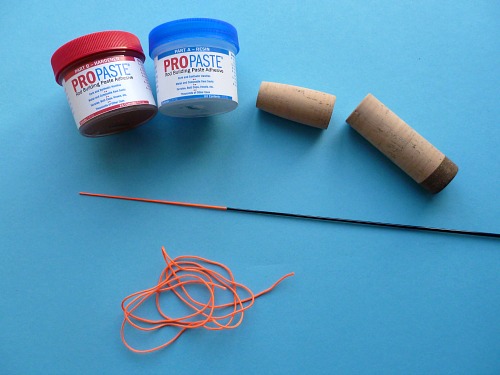 All the components for a sculpin rod.
All the components for a sculpin rod.It turns out that Mudhole has about anything you could want for rod building (except the lillian). I ordered a few ice fishing blanks (last I checked, $4.50 each), some grip sections (3" rear grip, 2" fore grip, $9.48 together), and some epoxy. The blank I thought would work the best is solid glass with a bright orange tip, which is almost the same color as some bright orange lillian I had. (If you do this and need a couple inches of orange lillian, let me know).
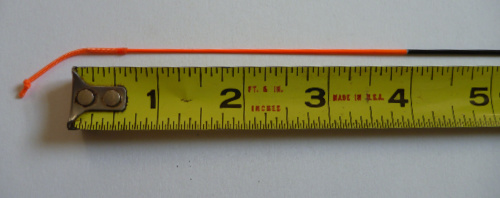 Orange lillian glued onto orange rod tip.
Orange lillian glued onto orange rod tip.Gluing the lillian onto the rod tip was very simple. A little epoxy on the rod tip and then slide the lillian on. With a one-piece rod, there is no reason not to have a knot in the lillian.
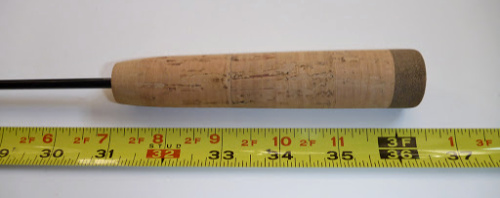
The grip was a little trickier. Companies that specialize in rod building supplies do not have sculpin-rod grips. A tapered cork foregrip and a separate ice rod rear grip glued on and glued together and then sanded to the point where the junction isn't obvious completed the rod.
Sculpin Fishing
Sculpin fishing, as it is done in Japan, is about as simple as making the rod. You can attach the line to the lillian with a girth hitch, the same way you would attach a furled line to a tenkara rod or a keiryu line to a keiryu rod. The line itself is just tippet, and the same 5X that you probably use for tenkara fishing would be fine.
The most interesting aspect to the line is that it is only 3 or 4 inches long! Clamp on a split shot in the middle of the line. Choose a hook based on the bait you choose. In Japan, the preferred bait seems to be salmon eggs. I am pretty sure that a small piece of worm would work as well, in which case an Owner Smallest or New Half Moon hook should work fine.
I suspect the same basic fishing method might work for darters also, where precise placement of the split shot and bait are critical. For darters, a hook with a smaller point would be better, perhaps the Owner Migen or Gamakatsu Ultimate.
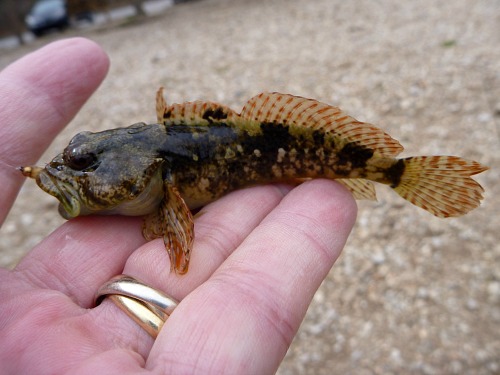
I have only caught sculpins once, and I have to admit it was not with my sculpin rod. I was at one of Missouri's Trout Parks, which are actually pretty similar to some of the managed, stocked, pay-to-fish "Areas" in Japan. I think most Areas are lakes, but there are stocked pay-to-fish streams as well. I was with Alan Luecke and Jeff Dannaldson. We all caught some trout, but as soon as Alan saw a sculpin, he and I started fishing for them.
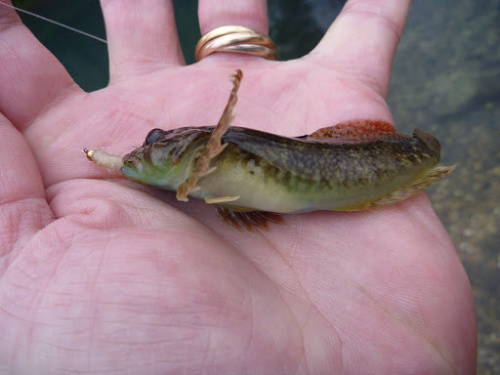
If we could see a sculpin on the bottom, all we had to do is put a
small bead head white Killer Bugger right in front of it and almost
without fail the sculpin would take the fly. A white Killer Bugger was
preferred because it was easier to see and thus to maneuver into the
right spot. (A white bead, as Rich Lee used in the Intro to Microfishing report, would do just as well.)
A second strategy was very much like the Japanese method shown in the video, but rather than sticking the rod tip and fly down between rocks, I dropped the Killer Bugger right beside a rock that had enough space for a sculpin to hide under it. Not all rocks had sculpins under them, but enough did to make that a viable strategy when no sculpins were visible in the open. A sculpin would come out to take the Bugger but only if it was within just a few inches of it's hideout.
So why catch 4" sculpins instead of 14" trout? I catch trout all the time. Sculpins, though, I'd never caught sculpins before. Besides, there is a special attraction to micro fishing. If you haven't tried it, do. If you have, you understand.
Update 8-11-19
This is a small section from my 8-11-19 trip report.
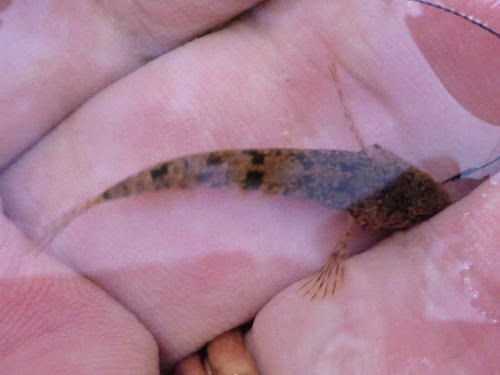
Yes, the sculpin was THAT small. My finger is not that fat! I hadn't planned on a micro fishing day, but when I saw a sculpin scoot under a rock, I had to stop to see if I could catch it. Following the previous day's micro trip, I made sure I had tanago hooks with me, including the Gamakatsu Ultimate, which was just the right size for this little guy. I should have brought a Micro Photo Box!
For bait I used speck of
worm - which I had for the keiryu fishing. I don't know if it would have
taken 1/4 of a Nikko Sashi but it might have. It probably would have
taken a tiny speck of salami from my lunch sandwich.
For a micro rod I used just the tip section from the Aoi ZPRO. In retrospect, the top two or three sections would have been better. Most of the micros, which appeared to be blacknose dace, were skittish and I couldn't get close enough with just the tip section. The sculpin hid under a rock when I approached, but came out when I placed a bit of worm right beside the rock.
TenkaraBum Home > Micro Fishing >Sculpin Fishing
“The bitterness of poor quality remains long after the sweetness of low price is forgotten” - Benjamin Franklin
"Be sure in casting, that your fly fall first into the water, for if the line fall first, it scares or frightens the fish..." -
Col. Robert Venables 1662
As age slows my pace, I will become more like the heron.
We've all had situations where seriously chewed up flies kept catching fish after fish after fish. It is no sin to tie flies that come off the vise looking seriously chewed up.
Warning:
The hooks are sharp.
The coffee's hot.
The fish are slippery when wet.
Beware of the Dogma
What's in stock?
Suntech Tenkarakyo 40F Tenkara Rods
Old Geezer's Wide-Eyed Fly Box
Coming Soon
December
Kurenai II AR 30F
Kurenai II AR 33F
Kurenai II AR 39F
Nissin Oni Line size 3
Nissin Oni Line size 3.5
TenkaraBum 33
TenkaraBum 36
TenkaraBum 40
Medium Rod Case
January
Furaibo TF39
Furaibo TF39TA
Latest Pages
Related Items
Gamakatsu Smallest, Owner Smallest and Gamakatsu Ultimate Hooks
If you enjoy spin fishing or baitcasting please visit my sister site Finesse-Fishing.com.
Black Friday sale on now. 15% off on all Tenryu spinning and baitcasting rods.


